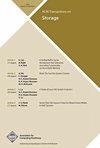Extending and Programming the NVMe I/O Determinism Interface for Flash Arrays
IF 2.6
3区 计算机科学
Q3 COMPUTER SCIENCE, HARDWARE & ARCHITECTURE
引用次数: 0
Abstract
Predictable latency on flash storage is a long-pursuit goal, yet unpredictability stays due to the unavoidable disturbance from many well-known SSD internal activities. To combat this issue, the recent NVMe IO Determinism (IOD) interface advocates host-level controls to SSD internal management tasks. Although promising, challenges remain on how to exploit it for truly predictable performance. We present IODA,1 an I/O deterministic flash array design built on top of small but powerful extensions to the IOD interface for easy deployment. IODA exploits data redundancy in the context of IOD for a strong latency predictability contract. In IODA, SSDs are expected to quickly fail an I/O on purpose to allow predictable I/Os through proactive data reconstruction. In the case of concurrent internal operations, IODA introduces busy remaining time exposure and predictable-latency-window formulation to guarantee predictable data reconstructions. Overall, IODA only adds five new fields to the NVMe interface and a small modification in the flash firmware while keeping most of the complexity in the host OS. Our evaluation shows that IODA improves the 95–99.99th latencies by up to 75×. IODA is also the nearest to the ideal, no disturbance case compared to seven state-of-the-art preemption, suspension, GC coordination, partitioning, tiny-tail flash controller, prediction, and proactive approaches.闪存阵列NVMe I/O确定性接口的扩展与编程
闪存上的可预测延迟是一个长期追求的目标,但由于许多众所周知的SSD内部活动的不可避免的干扰,不可预测性仍然存在。为了解决这个问题,最近的NVMe IO确定性(IOD)接口提倡对SSD内部管理任务进行主机级控制。尽管前景广阔,但如何利用它获得真正可预测的性能仍然存在挑战。我们介绍了IODA,1,这是一种I/O确定性闪存阵列设计,建立在IOD接口的小型但强大的扩展之上,以便于部署。IODA利用IOD上下文中的数据冗余来实现强大的延迟可预测性契约。在IODA中,预计SSD会故意使I/O快速失效,从而通过主动数据重建实现可预测的I/O。在并发内部操作的情况下,IODA引入了繁忙的剩余时间暴露和可预测的延迟窗口公式,以确保可预测的数据重建。总体而言,IODA只在NVMe接口中添加了五个新字段,并在闪存固件中进行了少量修改,同时在主机操作系统中保留了大部分复杂性。我们的评估表明,IODA将95–99.99秒的延迟提高了75倍。与七种最先进的抢占、暂停、GC协调、分区、微尾闪控制器、预测和主动方法相比,IODA也是最接近理想的无干扰情况。
本文章由计算机程序翻译,如有差异,请以英文原文为准。
求助全文
约1分钟内获得全文
求助全文
来源期刊

ACM Transactions on Storage
COMPUTER SCIENCE, HARDWARE & ARCHITECTURE-COMPUTER SCIENCE, SOFTWARE ENGINEERING
CiteScore
4.20
自引率
5.90%
发文量
33
审稿时长
>12 weeks
期刊介绍:
The ACM Transactions on Storage (TOS) is a new journal with an intent to publish original archival papers in the area of storage and closely related disciplines. Articles that appear in TOS will tend either to present new techniques and concepts or to report novel experiences and experiments with practical systems. Storage is a broad and multidisciplinary area that comprises of network protocols, resource management, data backup, replication, recovery, devices, security, and theory of data coding, densities, and low-power. Potential synergies among these fields are expected to open up new research directions.
 求助内容:
求助内容: 应助结果提醒方式:
应助结果提醒方式:


